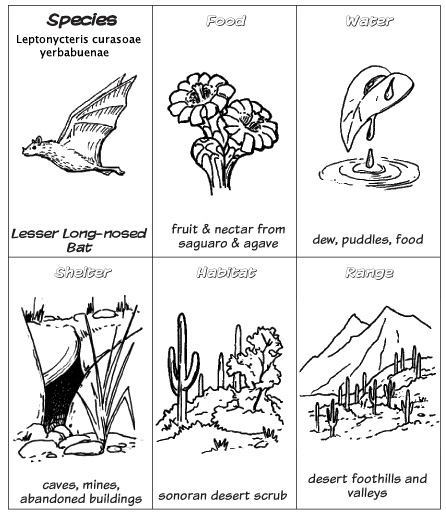

Directions: Print two copies of the card, then select the remaining cards from the Learning Materials menu.


Lesser Long Nosed Bat - Leptonycteris curasoae yerbabuenae
Description: The lesser long-nosed bat is a medium sized bat. Adults have yellow-brown or gray fur above, and rusty brown fur below. It has a small tail, small ears, and a triangular noseleaf jutting from the end of its nose.
Habitat: In the US, lesser long-nose bats are typically found in the desert scrub habitat. Roosting occurs in caves, abandoned buildings and mines, usually at the base of mountains where food sources are present.
Range: Much of Leptonycteris curasoae yerbavuenae range occurs in Pima County including several major maternity roosts. It is a migratory species that spends summers in Arizona and New Mexico.
Diet: The lesser long-nosed bat is one of the three North American bats that feeds almost exclusively on fruit and nectar from night-blooming columnar cacti such as saguaro and organ pipe. Agave flowers also play a principal role in the bat's diet. By eating the nectar, pollen, and fruit of these species of plants, the bat is an important pollinator.
The bat is a "keystone mutualist" because of its role as a pollinator. Without the bats to pollinate numerous species of cacti and agave, many fear the desert ecosystem would begin to decline. Protection of the lesser long-nosed bat would contribute to preserving the dominant plant forms of the Sonoran Desert.
Status: On August 30, 1988, the lesser long-nosed bat was listed as endangered throughout Mexico and Arizona.
Sonoran Desert Conservation Plan • Pima County Administrator’s Office • 130 West Congress, 10th floor, Tucson, AZ 85701-1317 • Phone: 520-740-8661 •
http://www.SDCPonline.org

 Go to quick links
Go to quick search
Go to navigation for this section of the ToL site
Go to detailed links for the ToL site
Go to quick links
Go to quick search
Go to navigation for this section of the ToL site
Go to detailed links for the ToL site